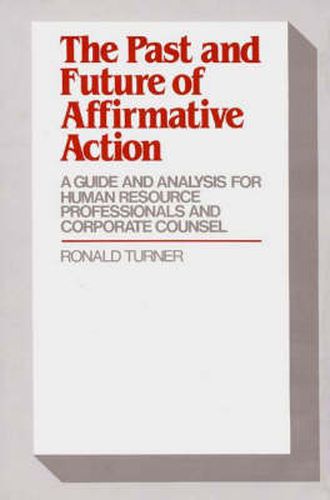Readings Newsletter
Become a Readings Member to make your shopping experience even easier.
Sign in or sign up for free!
You’re not far away from qualifying for FREE standard shipping within Australia
You’ve qualified for FREE standard shipping within Australia
The cart is loading…






Affirmative action has been and continues to be a volatile, complex, and hotly debated issue. In this volume, Ronald Turner provides a comprehensive guide through the maze of preferential treatment doctrine, U.S. Supreme Court decisions relating to affirmative action, and agency regulations and practices. Rather than focus on the moral or constitutional issues invloved, the author seeks to provide an objective analysis of the evolution of the legal concept of affirmative action–to describe what the law has actually meant in practice rather than juge whether affirmative action is either right or wrong, constitutional or unconstitutional. To this end, Turner defines and examines what affirmative action was in the early 1970s when the concept was first enshrined in law and explores how the Supreme Court is now interpreting the concept. He also discusses cases involving set-aside programs and analyzes other federal and state government programs in which constitutional principles and Executive Orders remain untouched by the Supreme Court’s recent conservative rulings. Following an introductory chapter in which he reviews the basic issues involved in the affirmative action debate, Turner discusses the origins and development of the affirmative action concept. He then examines affirmative action in the employment jurisprudence of the U.S. Supreme Court and the application of the Court’s rulings by the lower courts in selected cases. The requirements of Executive Order 11246 and its implementing regulations and the impact of the order on federal contractors are detailed in a seperate chapter. Turner also offers a brief treatment of the Equal Employment Opportunity Commission’s affirmative action guidelines. Finally, the author explores the judicial review of minority and women business enterprise programs, with particular emphasis on the Supreme Court’s 1989 ruling which invalidated a minority business enterprise statute enacted by the city of Richmond, Virginia. By thoroughly analyzing the record of the courts and legislative and administrative initiatives in affirmative action, this book offer guidelines and information which will be invaluable to all segments of the labour management community involved in and responsible for affirmative action and preferential treatment of minorities and women.
$9.00 standard shipping within Australia
FREE standard shipping within Australia for orders over $100.00
Express & International shipping calculated at checkout
Affirmative action has been and continues to be a volatile, complex, and hotly debated issue. In this volume, Ronald Turner provides a comprehensive guide through the maze of preferential treatment doctrine, U.S. Supreme Court decisions relating to affirmative action, and agency regulations and practices. Rather than focus on the moral or constitutional issues invloved, the author seeks to provide an objective analysis of the evolution of the legal concept of affirmative action–to describe what the law has actually meant in practice rather than juge whether affirmative action is either right or wrong, constitutional or unconstitutional. To this end, Turner defines and examines what affirmative action was in the early 1970s when the concept was first enshrined in law and explores how the Supreme Court is now interpreting the concept. He also discusses cases involving set-aside programs and analyzes other federal and state government programs in which constitutional principles and Executive Orders remain untouched by the Supreme Court’s recent conservative rulings. Following an introductory chapter in which he reviews the basic issues involved in the affirmative action debate, Turner discusses the origins and development of the affirmative action concept. He then examines affirmative action in the employment jurisprudence of the U.S. Supreme Court and the application of the Court’s rulings by the lower courts in selected cases. The requirements of Executive Order 11246 and its implementing regulations and the impact of the order on federal contractors are detailed in a seperate chapter. Turner also offers a brief treatment of the Equal Employment Opportunity Commission’s affirmative action guidelines. Finally, the author explores the judicial review of minority and women business enterprise programs, with particular emphasis on the Supreme Court’s 1989 ruling which invalidated a minority business enterprise statute enacted by the city of Richmond, Virginia. By thoroughly analyzing the record of the courts and legislative and administrative initiatives in affirmative action, this book offer guidelines and information which will be invaluable to all segments of the labour management community involved in and responsible for affirmative action and preferential treatment of minorities and women.